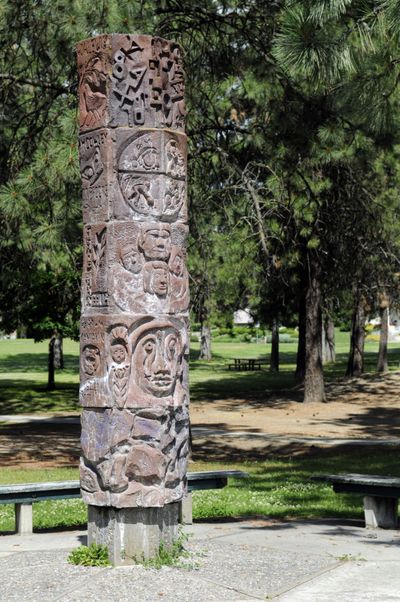Pillar in park reveals story about heritage

No matter where you go throughout Spokane, you’re likely to come across a sculpture by Sister Paula Mary Turnbull – from a garbage-eating goat at Riverfront Park to a Sasquatch at Spokane Community College to a “Fish On” sculpture at the Spokane Water Reclamation Facility along the Spokane River, a tribute to worker Mike Cmos, who was killed there in a sewage tank accident in 2004.
Her works vary in theme and style, from the religious to the whimsical, but perhaps one of the most intriguing – and surely the most collaborative – is the 10-foot carved pillar that stands at the east side of Indian Trail Park near the intersection of Woodside Avenue and Fleming Street on Spokane’s North Side. The piece, sponsored in 1967 by the North Spokane Rotary Club and the Spokane Parks Department, looks something like a totem pole, but is in fact a story pillar, Turnbull said.
Most totem poles are carved from wood with a story told on one side and with the back side being flat, she explained, but this story pillar consists of five sections made of clay, surrounding a concrete core, telling a story on the two main faces and the two edges.
Forty-two years ago, about a dozen students in her sculpture class at Fort Wright College researched and designed the project under her direction. The idea was to honor the heritage of the area, near Indian Trail Road, which in earlier years had served as a thoroughfare for American Indians and settlers traveling from Spokane Falls to the pioneer Colville road and toward the Columbia River.
There are 30 panels on the column arranged in levels depicting different themes. The bottom section represents the rocks native to the area and includes the kind of Indian paintings often found on them. The second section shows Indians, missionaries and settlers of the area, including some of their faces and names (Chief Garry, Chief Joseph, Father Desmet and others), and the third section has a family motif because the pillar stands in a park in a residential neighborhood.
Finishing off the pillar are playground images (there is a playground right behind the pillar) and at the top are numbers and letters – Roman, Arabic, Chinese and more – and words in several languages to represent the sciences and the humanities.
Though it’s been several decades since the project was done, Turnbull, who chaired the bachelor of fine arts program at Fort Wright College for many years, said it is still meaningful to her to have been able to help a group of students create this work of art. The Sisters of the Holy Names of Jesus and Mary, the Roman Catholic order to which she belongs, is devoted primarily to teaching and working with the poor.
And she is still an active sculptor today, working on four commissions – including sculptures to be installed at the new swimming pool in Hillyard and a statue of Father Cataldo for the Nez Perce Tribe. She has no intention of retiring, ever.
“No, no, I have no plans to retire. What else would I do? I’m still glad to still be able to do what I love to do,” said Turnbull, who works daily at her studio at the Convent of the Holy Names, amid the trees and the beauty and the heritage of a region she clearly cherishes.